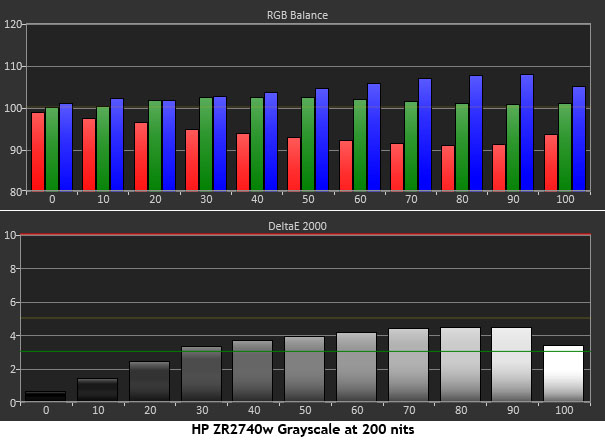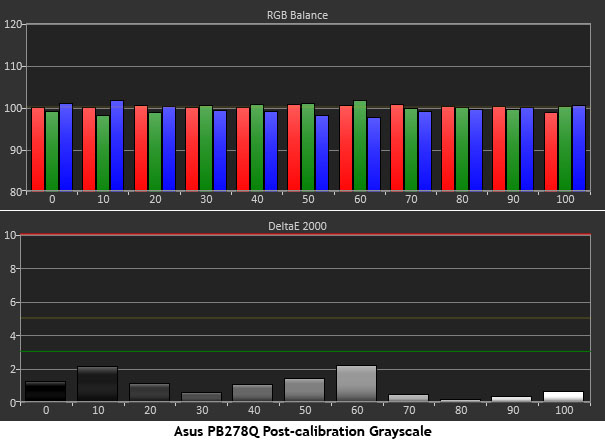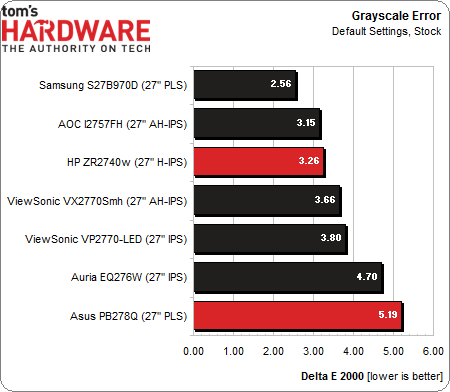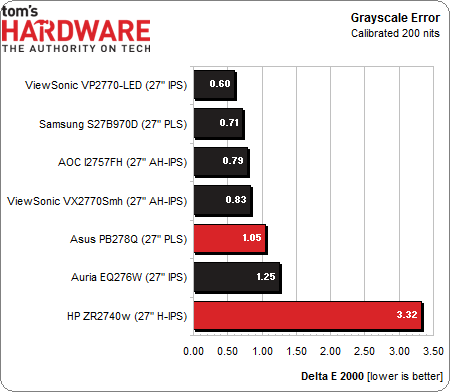HP ZR2740w Versus Asus PB278Q: QHD 27" Monitors, Tested
Until cutting-edge UHD (3840\00d72160) displays hit the mainstream, most enthusiasts have to be content with QHD monitors at 2560x1440 pixels. In the lab today, we have two more 27-inch QHD screens: the ZR2740w from HP and the PB278Q from Asus.
Results: Grayscale Tracking
All of the IPS panels that we’ve tested recently display excellent grayscale tracking, even at stock settings. It’s important that the color of white be consistently neutral at all light levels from darkest to brightest. Grayscale performance impacts color accuracy with regard to the secondary colors (cyan, magenta, and yellow). Since computer monitors typically have no color or tint adjustment, accurate grayscale is key.
HP ZR2740w
Since the HP has no RGB controls to adjust grayscale, we’re showing the measurement at a 200 cd/m2 brightness level.
This is a fair result. Grayscale error is visible from 30 percent to 100 percent, though just barely. The overall tint is cool in tone with just a hint of blue in white parts of the image. We ran this test at both minimum and maximum brightness settings and got nearly the same results. This is a good thing in that the HP achieves the same level of accuracy no matter what its light output.
Asus PB278Q
At its stock settings the PB278Q is deficient in green (a deficiency that increases as the signal level goes up). Bright images like the white background of a word processing app or Web browser look obviously blue. This measurement was taken in the User mode at the 6500K color temp preset. Standard mode looks the same as the above. sRGB mode is slightly better, though still blue in tone.
Fortunately, Asus includes RGB adjustments for both the high and low range, which is unusual for any computer monitor. This allows you dial in grayscale more precisely. Our procedure is to adjust the high range (gain) using an 80 percent signal and the low range (offset) using a 30 percent signal.
Get Tom's Hardware's best news and in-depth reviews, straight to your inbox.
The extra adjustability allows a very accurate result in our grayscale tracking test. All the errors are now below two, except at 10 and 60 percent. In fact, most brightness levels are below one Delta E in this test. This is excellent performance.
Since most users lack the equipment to calibrate their monitors, out-of-box performance is important, especially in the grayscale metric. An error of over three Delta E is visible to the naked eye. Since most productivity apps have a white background, any tint can easily be seen.
The HP finishes third in this comparison. Its average grayscale error is barely visible. In fact, most people would not notice an issue. We used this monitor exclusively for several days and found it excellent for all types of content. The value of 3.26 Delta E was measured at the maximum brightness setting. The Asus comes in at the bottom of the default settings test. While not a grievous result, an instrumented calibration will improve the performance of the PB278Q greatly.
Here’s the line-up after calibration to 200 cd/m2.
The HP doesn’t really change when its brightness is reduced from over 400 cd/m2 to 200. This is a good thing since it shows consistency. The Asus looks great after calibration, and our measurements support this observation. Its grayscale performance is right there with the best screens we’ve tested. All of the monitors we’ve reviewed recently do extremely well in this test. In fact, many far more expensive consumer televisions don’t measure this well.
Current page: Results: Grayscale Tracking
Prev Page Results: Gamma And ANSI Contrast Ratio Next Page Results: Color Gamut And Performance
Christian Eberle is a Contributing Editor for Tom's Hardware US. He's a veteran reviewer of A/V equipment, specializing in monitors. Christian began his obsession with tech when he built his first PC in 1991, a 286 running DOS 3.0 at a blazing 12MHz. In 2006, he undertook training from the Imaging Science Foundation in video calibration and testing and thus started a passion for precise imaging that persists to this day. He is also a professional musician with a degree from the New England Conservatory as a classical bassoonist which he used to good effect as a performer with the West Point Army Band from 1987 to 2013. He enjoys watching movies and listening to high-end audio in his custom-built home theater and can be seen riding trails near his home on a race-ready ICE VTX recumbent trike. Christian enjoys the endless summer in Florida where he lives with his wife and Chihuahua and plays with orchestras around the state.




